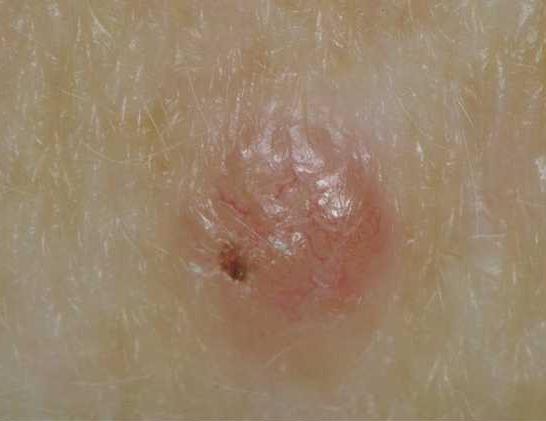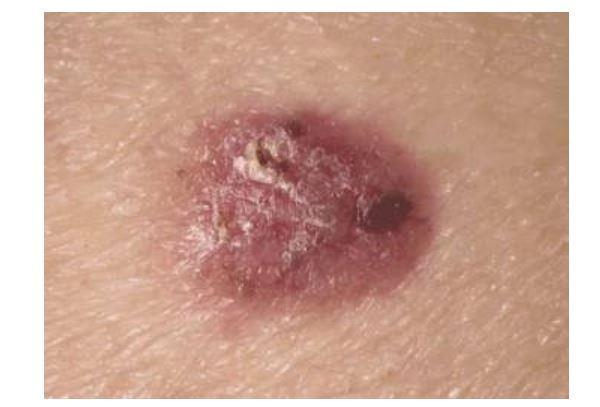Basal cell carcinoma
What is Basal Cell Carcinoma?
BCC is the most common type of skin cancer, making up more than 75% of all skin cancers. They develop from the basal (bottom) layer of the epidermis. BCCs are slow growing. They rarely spread to other parts of the body, and are almost always completely cured by treatment. However, if left untreated, BCCs have the potential to invade and destroy the surrounding skin and tissues.
Basal cell carcinoma usually develops on sun-exposed areas of the body, such as the head, face, neck, shoulders, back, lower arms and lower legs, but it can occur anywhere on the body
It may appear as a pearl-coloured lump or as a slightly scaly area that is shiny and pale or bright pink in colour, although some BCCs are pigmented or brown in colour.
It may bleed and become inflamed or fail to heal
It tends to grow slowly over months or years

Risk Factors for Basal Cell Carcinoma
Exposure to ultraviolet (UV) radiation from the sun (including solariums) is by far the most important factor in the development of BCCs and most skin cancers. Those who are at a greater risk of developing a basal cell carcinoma include people with fair skin, a history of previous BCC or skin cancer, people with a strong family history of skin cancer or BCC and those aged over 50.

How are BCCs treated?
Usually a biopsy (a small sample of the lesion) is taken and sent to the pathology laboratory to be examined under the microscope to confirm the diagnosis. The BCC is then treated with the most appropriate method, given the person’s health and age, the size and site of the lesion and the type of BCC.
Surgery
Surgery is the most common treatment for skin cancer. This involves cutting out the lesion and suturing (stitching) the skin back together. The cure rate is greater than 90% with this technique.
It is usually performed by a GP or a dermatologist in their rooms. More complex cases may be treated by a surgeon in hospital. A type of surgery - Mohs microscopically controlled excision surgery, is highly specialised and reserved for advanced BCCs on the face.
Cryotherapy
This involves spraying the tumor with liquid nitrogen (-196°c) This method is mainly used to treat superficial BCCs. The liquid nitrogen freezes and kills the abnormal cells and creates a wound that will heal from new healthy skin. The healed skin can look more pale than the surrounding skin.
Curettage and cautery
Curettage and cautery is usually performed by a GP or dermatologist. The doctor will give an injection of local anaesthetic, followed by scraping the lesion from the skin surface with a curette and then applying low heat to the base to stop bleeding and destroy any remaining cancer cells (cauterization) It is often used for superficial BCCs. The cure rate is generally in the vicinity of 90% and the procedure typically heals with a pale scar.
Topical treatments
Topical immunotherapy involves daily application of a special cream (imiquimod) that stimulates the body’s own immune system to fight and destroy the skin cancer cells. Sunspots, superficial BCCs and superficial SCCs can be treated using this method.
A topical chemotherapy cream 5-FU (Efudix) can be used to treat superficial BCCs, sunspots and sometimes superficial SCCs.
Ingenol Mebutate is a newer treatment for sunspots that you apply to the affected skin for two to three days.
Photodynamic therapy (PDT)
This involves the application of a light sensitising cream to the tumor followed by exposure to a specialised light source to treat sunspots, superficial BCCs and superficial SCCs (Bowen disease). It has a lower chance of scar formation than other treatments and its cure rate is 80% or less.
Radiation therapy
Radiotherapy is occasionally used for cancers that are hard to treat due to tumor type, tumor site, tumor spread or patient age of health conditions.
New oral therapy for treatment of BCC
Vismodegib is a new treatment for people with BCC that has spread and who aren’t suitable for surgery and radiation therapy. It is taken as a tablet once a day. Common side effects include muscle spasms, taste changes and upset stomach
